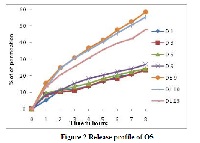Development and In Vitro Evaluation of Matrix Type Transdermal Delivery of Ondansetron Hydrochloride.
Keywords:
Ondansetron Hydrochloride, dibutylsebacate, triethyl citrate, eugenol, linseed oilAbstract
Release and permeation studies were carried out with the objective of developing transdermaltherapeutic systems with Ondansetron Hydrochloride (OS).The patches were prepared with Eudragit RSPO/RLPO as polymer and dibutylsebacate (DBS) and triethyl citrate (TEC) as the plasticizer in different compositions. Thickness, tensile strength, drug content, moisture content and water absorption studies of the patches were measured. In vitro release/permeation of OS was studied by using a Franz diffusion cell. Chemical enhancers like eugenol and Virgin linseed oil were added to compare the release pattern of the drug. All the formulations are developed and passed the mechanical as well as physiochemical properties, while in the case of release profile, the patch containing DBS had better percentage cumulative release compared to those with TEC containing patches. Eugenol acted as a good chemical enhancer as it increased percentage of permeation compared to linseed oil significantly. The ratio of Eudragit RSPO/RLPO (1:1) with combination of using 25% DBS as plasticizer and 3% eugenol as chemical enhancer favourable release profile. The selected formulations may be used for further pharmacokinetic and pharmacodynamic studies in suitable animal models.
References
Rita Wickham. Best Practice Management of CINV in Oncology Patients: II. Antiemetic Guidelines and Rationale for Use. The Journal of Supportive Oncology 2010; 8(1) 10-15.
Ruff P, Paska W, Goedhals L et al.. Ondansetron compared with granisetron in the prophylaxis of cisplatin-induced acute emesis: A multicentre double-blind, randomised, parallelgroup study. Oncology 1994; 51(1) 113-118.
Swain K, Pattnaik S, Sahu SC, Mallick S. Feasibility assessment of ondansetron hydrochloride transdermal systems: physicochemical characterization and in vitro permeation studies. Lat Am J Pharm 2009;28(5):706-714.
Figg WD, Dukes GE, Pritchard JF, Hermann DJ, Lesesne HR, Carson SW. Pharmacokinetics of ondansetron in patients with hepatic insufficiency. J Clin Pharmacol 1996 Mar;36(3):206-215.
Gwak HS, Oh IS, Chun IK. Transdermal delivery of ondansetron hydrochloride: effects of vehicles and penetration enhancers. Drug Dev Ind Pharm 2004;30(2):187-194.
Sheth NS, Mistry RB. Formulation and evaluation of transdermal patches and to study permeation enhancement effect of eugenol. J App Pharm Sci 2011;1(3):96-101.
Gal A, Nussinovitch A. Plasticizers in the manufacture of novel skin-bioadhesive patches. Int J Pharm 2009;370:103-109.
Rajabalaya R, Khanam J, Nanda A. Design of a matrix patch formulation for long-acting permeation of diclofenac potassium. Asian J Pharm Sci 2008;3(1):30-39.
Wu C, McGinity JW. Influence of ibuprofen as a solid-state plasticizer in Eudragit® RS 30 D on the physicochemical properties of coated beads. AAPS PharmSciTech 2001;2(4):article 24.
Krishnaiah YSR, Kumar MS, Raju V, Lakshmi M, Rama B. Penetration-enhancing effect of ethanolic solution of menthol on transdermal permeation of ondansetron hydrochloride across rat epidermis. Drug Deliv 2008;15:227-234.
Pattnaik S, Swain K, Mallick S, Lin Z. Effect of casting solvent on crystallinity of ondansetron in transdermal films. Int J Pharm 2011;406:106-110.
Swain K, Pattnaik S, Sahu SC, Mallick S. Feasibility assessment of ondansetron hydrochloride transdermal systems: physicochemical characterization and in vitro permeation studies. Lat Am J Pharm 2009;28(5):706-714.
Rajan R., Sheba Rani N.D., and Kajal G.. Design and in vitro evaluation of chlorpheniramine maleate from different eudragit based matrix patches: Effect of platicizer and chemical enhancers. Ars Pharm, Vol. 50 nº4; 177-194.
Rajan Rajabalaya, Sheba Rani Nakka David, and et al.. Studies on the effect of plasticizer on in vitro release and ex vivo permeation from Eudragit E 100 based chlorpheniramine. JEFC 2010; 1 (2) 3-12.
J. Siepmann, F. Lecomte and R. Bodmeier. Diffusion-controlled drug delivery systems: calculation of the required composition to achieve desired release profiles. Journal of Con Rele. 1999; 60(2-3): 379-389.
Jenquin MR., Stephen M. Liebowitz, Rafael E. Sarabia, James W. McGinity. Physical and chemical factors influencing the release of drugs from acrylic resin films Journal of Pharm. Sci., 1990;79 (9): 811 - 816.
Rajan R., Jasmina., Arunabha N. Design of a matrix patch formulation for long-acting permeation of diclofenac potassium. A J Pharm Sci, 2008;3(1): 30-39.
Sogol Kangarlou, Ismaeil Haririan, Yaghob Gholipour. Physico-mechanical analysis of free ethyl cellulose films comprised with novel plasticizers of vitamin resources. Int Journal of Pharmaceutics 2008; 356: 153–166.
K.S. Shih and C.L. Beatty. Blends of polycarbonate and poly (hexamethylene sebacate). II: Effect of molecular weight on compatibilityPolym Engng Sci 1987;27(2): 1530–1541.
Chandra A, Sharma PK, Irchhiaya R. Effect of alcohols and enhancers on permeation
enhancement of ketorolac. Asian J Pharm, 2010; 37-42.
Chandra A, P K Sharma, R Irchhiaya. Microemulsion-based hydrogel formulation for transdermal delivery of dexamethasone. Asian J Pharm. 2009 ; 3(1): 30-36.






